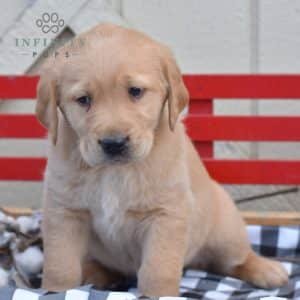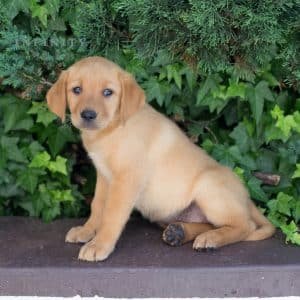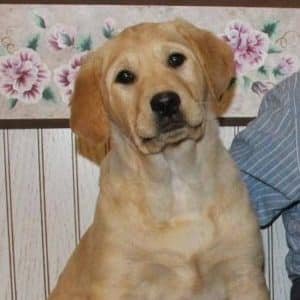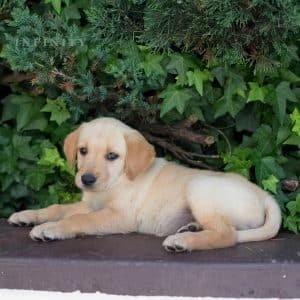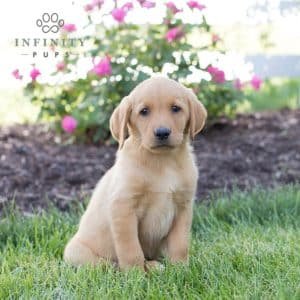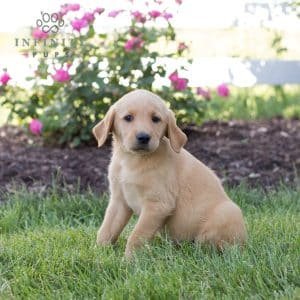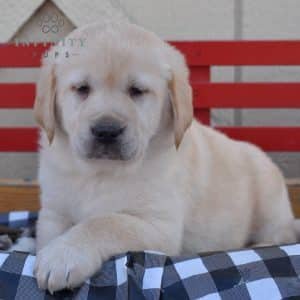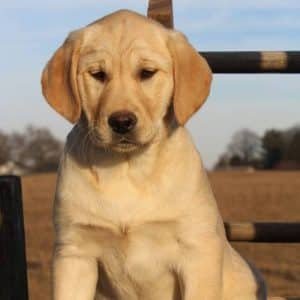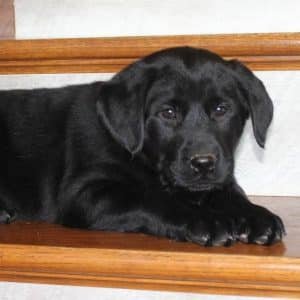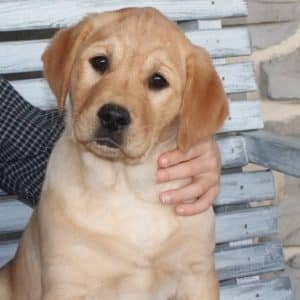Sorry, no puppies of this breed are currently available. Contact us to be notified when more are listed for adoption.
Have a question about our Goldador puppies?
"*" indicates required fields
overview of the Goldador Dog Breed
Are you looking for a beautiful, loyal, friendly, and intelligent dog breed?
Check out our Goldador puppies for sale below!
A cross between two of America’s most popular breeds: a Golden Retriever and a Labrador Retriever, the Goldador is a playful, family-friendly dog that excels in many areas!
Friendly, loyal, intelligent, and easy to train, the Goldador (Golden Lab Mix) excels in dog sports, therapy work, and search and rescue. They make excellent family companions too!
Adopt your Goldador puppy today and start a friendship with this talented, loyal, and loving breed! If you are looking for something different, browse our selection of dog breeds on our “all breeds” page.
Goldador temperament
Active: Whether it’s a walk, game of fetch, or a swim (they LOVE swimming!) Goldadors enjoy being on the move with their family members! They excel in dog sports, including agility, obedience, and tracking.
Intelligent: Labrador Retrievers and Golden Retrievers are some of the most intelligent dog breeds, according to dog expert Dr. Stanley Cohen. Goldadors will be able to learn a new command in just a few repetitions. They can learn up to 200 spoken words.
Family Companionship: Goldadors often form strong bonds with their human families. They thrive on companionship and can become anxious or bored if left alone for long periods of time.
Water Love: Both Golden Retrievers and Labrador Retrievers have a natural affinity for water. Goldadors often inherit this love for water activities, which can make them great companions for outdoor adventures involving water.
Eager to Please: Goldadors love humans and want to make them happy. Their loyal, eager-to-please spirit makes them easy to work with and train. Therapy work and Search and rescue are great options for this intelligent, eager-to-please breed.
Friendly: Golden Lab Mixes are friends with everyone and are happiest when they are with people! They get along great with children and other dogs and pets. However, you should always supervise your Goldador when playing with small animals.
Not a Good Guard Dog: Goldadors are good watchdogs – they will bark if they see something unusual. But don’t rely on your Goldador to keep an intruder out of your house. Once the stranger pets them or gives them a treat, they’ll start wagging their tail.
A Goldador is a hybrid dog breed that results from the crossbreeding of a Golden Retriever and a Labrador Retriever. As such, Goldador puppies tend to inherit characteristics from both parent breeds. Here are some common characteristics of Goldador puppies:
- Temperament: Goldadors are known for their friendly, outgoing, and affectionate nature. They are typically good with children and other pets, making them excellent family dogs.
- Intelligence: Both Golden Retrievers and Labrador Retrievers are highly intelligent breeds. Goldadors tend to be smart and eager to learn, making them relatively easy to train.
- Energy Level: Goldador puppies are usually quite energetic and playful. They require regular exercise and mental stimulation to keep them happy and healthy.
- Size: Goldadors are generally medium to large-sized dogs. Their size can vary depending on the size of the parent breeds, but they typically weigh between 55 to 80 pounds (25 to 36 kg).
- Coat: Goldadors often have a short to medium-length double coat that is dense and water-resistant. Coat colors can vary widely, but they often come in shades of gold, cream, or yellow.
- Shedding: Due to their double coat, Goldadors can shed a moderate amount. Regular grooming, including brushing their coat, can help manage shedding and keep their coat looking its best.
- Health: Like all dog breeds, Goldadors can be prone to certain health issues. Common concerns include hip and elbow dysplasia, ear infections (due to their floppy ears), and obesity. Regular veterinary care and a healthy diet are important for their overall well-being.
- Social Nature: Goldadors are typically sociable dogs that enjoy being around people and other dogs. They may have a tendency to be friendly with strangers, making them potentially good candidates as therapy or service dogs.
- Family Companionship: Goldadors often form strong bonds with their human families. They thrive on companionship and can become anxious or bored if left alone for long periods of time.
- Water Love: Both Golden Retrievers and Labrador Retrievers have a natural affinity for water. Goldadors often inherit this love for water activities, which can make them great companions for outdoor adventures involving water.
Remember that while these are general characteristics, individual Goldador puppies can vary based on factors like genetics, upbringing, and socialization. If you’re considering bringing a Goldador puppy into your home, it’s important to research the breed thoroughly, meet the puppy’s parents if possible, and provide proper training, socialization, and care to ensure a well-adjusted and happy companion.
Goldador Breed history
Goldadors, or Golden Labs, are a designer breed that was developed more than a decade ago in America and has often been used as a guide or assistance dog.
Goldadors aren’t very common, but their parent breeds, Golden Retrievers and Labrador Retrievers are in the top 5 most popular dog breeds in America every year!
Goldadors are also called Golden Labs and Golden Retriever/Lab Mix. Here are some dog registries that may accept the Goldador:
- ACHC = American Canine Hybrid Club
- DBR = Designer Breed Registry
- DDKC = Designer Dogs Kennel Club
- DRA = Dog Registry of America, Inc.
- IDCR = International Designer Canine Registry
To learn more about Goldadors, let’s look at the history of the Golden Retriever and the Labrador Retriever!
History of the Golden Retriever
The Golden Retriever breed has its origins in the Scottish Highlands in the late 1800s. Dudley Marjoribanks, also known as Lord Tweedmouth, was a gentleman dedicated to carefully breeding dogs and cattle.
His ultimate goal in breeding dogs was to create a breed that would do well in the Scottish climate and love hunting and retrieving the local game.
In 1865, Marjoribanks bred Yellow Retrievers, Tweed Water Spaniels, Irish Setters, and Bloodhounds.
Over time, this breeding led to the beloved Golden Retriever.
The Golden Retriever was first shown at a dog show in Britain in 1908 and was brought to Canada and America around the same time. The breed was loved by sport hunters and show fanciers alike.
The AKC accepted the Golden Retriever in 1925, but its popularity grew during President Gerald Ford’s time in office in the 70s. He owned a Golden Retriever named Liberty.
History of the Labrador Retriever
The Labrador Retriever breed has its origins in Newfoundland, which is off the Canadian coast. Originally called “St. John’s Dog,” they were used as retrievers in the water for hunters and fishermen.
It is thought that the St. John’s Dog was crossbred in the 1700s with the Newfoundland Dog and other smaller water dogs.
British sailors who visited northern North America noticed the speed and ability of these dogs, and they began bringing them back to England. One of the most notable British to bring back one of these dogs was the Earl of Malmesbury. He used his new dogs to help hunt in the swamps and water of his estate.
The breed continued to grow in popularity, and in 1903 the Labrador Retriever was officially recognized by the English Kennel Club.
The American Kennel Club recognized the Labrador Retriever in 1917.
Goldador Average size
Goldadors, or Golden Lab Mixes, weigh between 55 and 80 pounds. They measure 21-24 inches tall at the shoulder.
Average Goldador lifespan
Goldadors usually live for about 10-12 years.
Goldador body features
Goldadors, or Golden Retriever/Lab, mix are usually sturdy, well-built dogs with wagging tails! They have dark eyes and a dark nose, and triangular ears that hang down on the sides of their face.
Goldadors often have a yellow coat, but they also can be chocolate brown or black.
Goldadors may have a long-haired coat like a Golden Retriever, or they may be short-haired like a Labrador. Whether long or short-haired, they will have thick, double coats just like their parents.
grooming Your Goldador Puppy
Goldadors, or Golden Retriever/Lab Mixes, have beautiful, thick double coats that need regular brushing. Their thick coat is waterproof and protects them from both cold and moisture.
Any dog breed with a double coat will shed heavily twice a year. During these times, you’ll want to brush your dog daily and bathe them more frequently to help remove the loose hair.
Your Goldador will need to be bathed at least once a month. You’ll probably end up bathing them more often since this breed is playful, energetic, and loves water, mud, digging, chasing, etc.
Your Goldador will also need its nails trimmed and teeth brushed regularly.
Keeping Your Goldador Puppy Healthy
For all crossbreeds, the puppies are susceptible to the conditions of both parents. In order to learn about conditions that may affect your Goldador, learn about conditions that may affect the Golden Retriever and the Labrador Retriever.
Hip and Elbow Dysplasia
Like all dog breeds, Goldadors are at risk for hip and elbow dysplasia, two of the most common health issues in dogs.
Hip and elbow dysplasia occurs when the thigh bone doesn’t fit snugly into the hip and can result in limping, lameness, or arthritis if it’s not addressed.
Hip and elbow dysplasia can be genetic, or it can be caused by environmental factors such as overeating or injuries.
Here are some ways to prevent hip dysplasia in your puppy:
- Ask the breeder for an OFA (Orthopedic Foundation for Animals) Hip Clearance. Dogs with hip dysplasia shouldn’t be bred.
- Talk to your vet about the right food for your puppy and stick to the correct amount to prevent unhealthy growth.
- Keep your puppy from running or jumping excessively on hard surfaces and from standing on their hind legs.
Bloat
Bloat, also called gastric dilatation-volvulus or gastric torsion, can affect any large breed dog and is a life-threatening condition.
Bloat is when the stomach becomes twisted, and the gasses in the stomach are unable to escape. The pressure from these gasses affects the blood flow to the heart, and it can be fatal.
To prevent bloat:
- Avoid feeding your dog right before or after heavy exercise.
- Feed them a few smaller meals a day instead of one large meal to prevent bloat.
- Learn to recognize the symptoms of bloat so you can take action immediately.
Some owners choose to have surgery done to tack their dog’s stomach in place and prevent it from twisting.
Protect Your Dog from Obesity
You can protect your Goldador, or Golden Lab, from one of the most common health problems: obesity. One of the best ways to extend your dog’s life is by feeding them the correct amount of food and giving them adequate exercise.
Other Conditions
Goldadors are also susceptible to diabetes, progressive retinal atrophy, and cataracts.
Typical Goldador Allergens
First of all, what causes allergies?
Allergens are caused by dander, which is dead skin cells. Both animals and humans shed these dead skin cells. Dander is attached to the fur that dogs shed.
Goldadors are heavy shedders and are not considered an allergen-friendly breed. Allergens can be lowered with regular brushing and bathing.
If you or someone in your home has animal allergy concerns, please consult your health provider before adopting a puppy.
- 1. Do Goldadors like water?Goldadors are a cross between Golden Retrievers and Labs, both of which were originally bred to swim and retrieve water game such as ducks. Given this, it’s not surprising that Goldadors love water! Of course, each dog has its own unique temperament, and some may be more interested in water than others.
- 2. Are Goldadors good family dogs?With their loyalty, intelligence, and trainability, Goldadors are excellent family dogs! Both parent breeds, Labs and Golden Retrievers, are among the most popular family dogs in the world, so the Goldador does not disappoint!
- 3. What jobs can Goldadors do?Goldadors are so intelligent they can do almost any job you want to train them for. They are popular therapy dogs, guide dogs, search and rescue dogs, bomb detectors, and companions. The only job they may not excel at is guard duty. They’ll warn you if things are out of the ordinary, but they are just too friendly to ward off intruders.
- 4. Do Goldadors become obese easily?Yes, it’s common for Goldadors to become overweight. One of the top things you can do to protect your dog’s health is to limit her food intake and keep her a healthy weight.
- 5. Are Goldadors common?Both Labs and Golden Retrievers are wildly popular, so it’s not surprising that Goldadors are a fairly common crossbreed. Their loyalty, friendly temperaments, and intelligence adds to their charm.
- 6. Do Goldadors wander off easily?Goldadors love to be near their families, so they don’t generally wander off if they have the option of being with their people. And with some time and effort, you can easily train them to “come” and “stay.” However, depending on individual personalities, some Goldadors may be more prone to wandering than others.
- 7. Are Goldadors difficult to groom?Goldadors have thick, double coats that shed year-round, with heavier shedding twice a year. They require moderate amounts of grooming to stay looking neat. Goldadors should be brushed regularly and may require some trimming around their ears, paws, and underbelly, but overall they are not considered a high-maintenance breed.
- 8. Do Goldadors make better outside dogs or indoor dogs?While it’s possible to keep a Goldador in an apartment, they generally do better outside. They are larger than some breeds, and they need space to play and run off their energy. If you do want to keep a Goldador as an apartment dog, be sure to give your pet plenty of exercise and mental stimulation to prevent boredom and destructive habits.
- 9. Are Goldadors high-energy?Goldadors are known as a high-energy breed that needs plenty of exercise. They are an ideal fit for active families that love hiking, camping, and other outdoor activities. Of course, every dog is different, and some Goldadors may need more exercise than others.
- 10. Do Goldadors relate well with kids?Goldadors normally do quite well with kids! With their friendly, sweet, playful natures they can make ideal playmates for kids. However, they may be a little exuberant for very small children, and you should always supervise playtime.



